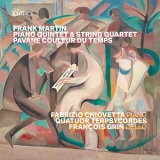Mit seinem Klagelied zu Beginn gibt das Cello den Ton im Klavierquintett von Frank Martin an. Es ist ein Ton in schattenhaften, geheimnisvollen Farben, der die Trauer und Melancholie unterstreicht. Gelegentlich wird diese von leidenschaftlichen Wallungen durchbrochen. Damit halten die Interpreten ständig Spannung und Intensität des Ausdrucks hoch. Das gilt ebenso für das intime Adagio mit einfühlsamer, klarer Stimmführung und herrlichen Nuancen: das Klavier sowohl hell als auch grüblerisch, darüber ein wehmütiges Quartett.
Im Finale erleben wir vorgegaukelte Leichtigkeit, die sich allmählich in einen spielerischen Tanz verwandelt – ein Traumtanz?
Terpsycordes und Fabrizio Chiovetta am Klavier schaffen es mit kleinstem Gestus eine höchst mögliche Ausdrucksdichte zu schaffen. Kein Akzent wird übertrieben, keine Emotion überladen, und dennoch bewegt uns diese Interpretation durch tiefste Eindringlichkeit.
Dies gilt ebenso für das späte Streichquartett von 1967, das rund 50 Jahre nach dem Quintett entstand. Auch hier steht zu Beginn ein Lamento, von der Bratsche initiiert und anschließend den Violinen mit übernommen. Wiederum fasziniert die Prägnanz des Klanges, ohne dass der natürliche Lauf der Musik angetastet wird. Im Presto hingegen herrscht ständige Unruhe, Unrast, abermals sparsam im Gestus aber packend in der Wirkung. Dieses Konzentrat von Musik setzt sich in den beiden folgenden Sätzen fort, wobei die Stimmung im Larghetto durch die würdevolle Rhythmik und den bitter zarten Gesang ihren feinen Fluss bis zum verhauchenden Ende nie unterbricht.
The cello sets the tone in Frank Martin’s Piano Quintet with its lament at the beginning. It is a tone in shadowy, mysterious colors that underscores the sadness and melancholy. This is occasionally interrupted by passionate outbursts. The performers keep the tension and intensity of expression constantly high. This is also true of the intimate Adagio, with its sensitive, clear voice-leading and wonderful nuances: the piano is both bright and brooding, with a wistful quartet above.
In the finale, we experience a feigned lightness that gradually transforms into a playful dance – a dream dance?
Terpsycordes and Fabrizio Chiovetta at the piano manage to create the greatest possible density of expression with the smallest of gestures. No accent is exaggerated, no emotion overloaded, and yet this interpretation moves us with the deepest urgency.
The same is true of the late String Quartet of 1967, written some 50 years after the Quintet. Here, too, there is a lament at the beginning, initiated by the viola and then taken over by the violins. Once again, the conciseness of the sound is fascinating, without interfering with the natural flow of the music. In the Presto, on the other hand, there is constant restlessness, anxiety, again sparing in gesture but gripping in effect. This concentration of the music continues in the following two movements, with the mood in the Larghetto never interrupting its fine flow through the dignified rhythms and the bitterly tender singing until the breathy end.
























